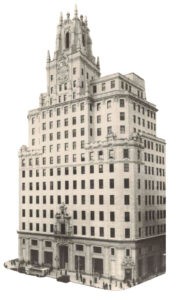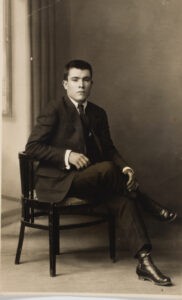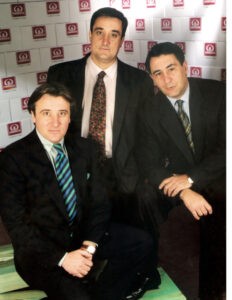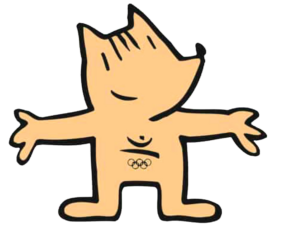
1923
The beginning of the company
Jesus Navaro graduates from the military service. It is then when he and his wife, Carmen Valero, found Carmencita.
Es entonces cuando
él y su esposa,
Carmen Valero, fundan Carmencita.
1926
Birth of Carmencita
Jesus and Carmen’s first daughter, is born; when Carmencita turns one, the brand is registered and the photo taken with an enormous bow on her head, which is what appears on the sachets of saffron.

1927
Spain begins to fly
On 28 June 1927 Iberia, Aerial Transport Company, is founded. In this decade the routes to peninsular cities, the Canary Islands and some points on the African coast are established.
On 14 December 1927 King Alfonso XIII presides over the opening of the first commercial Madrid – Barcelona flight.


1929
The first skyscrapers
The Telefonica building is erected between 1926 and 1930, and was the first skyscraper in Spain and, for a brief time, the tallest building in Europe. Inside it 1,800 people worked, including the famous telephone operators who inserted the plugs into the big switchboard.
Football arrives

The first year of the Spanish football league is opened. The first league champion is the Barcelona Football Club.
1930
Brand registered
Without a bow, with a Cordoban hat and dressed as an Andalusian with a Manila shawl and carnation, the Carmencita we know today is born.


New registry with the image of Carmencita with the Cordoban hat and curl, which continues to this day.
1931
Spanish women gain the vote

Female suffrage did not exist in Spain at the beginning of the 1930s. Member of parliament Clara Campoamor, standard bearer for the suffragist movement, gets to see it approved in parliament on 1 October 1931.
1935
First film legends
In 1935, “La Verbena de la Paloma (The Fair of the Virgin of la Paloma)” of Benito Perojo, becomes the first great Spanish film hit. In 1939, Luis Buñuel and Dalí premiere “El Perro Andaluz (The Andalusian dog)” in Paris.

The businessman Jesus Navarro Jover.
1938
The first advertising

During the years of the Second Republic, Carmencita starts to advertise, with ads for its sachets of saffron in cinema intermissions and on advertising hoardings.
1945
The difficult
1940s Jesus Navarro and Carmen Valero, photographed in 1945 and, next to them, an example of Carmencita’s business advertising of the time.




The first machines are introduced to speed up the process of filling the sachets with saffron, which marks a big step toward satisfying the ever growing demand and the possibility of opening the market to other spices.
1950
The saffron revolution

1957
The first “Seiscientos”

start up The production of the first 5,000 Seat 600s is begun. Reflection of an emerging Spain in which a certain amount of economic growth is noted. “The day that Spaniards got into the 600, they began to distance themselves from their past and started a weekend outing trom which they have still not returned”. Manuel Vazquez Montalbán.
1959
Severo Ochoa wins the Nobel Prize

Severo Ochoa de Albornoz, Spanish physician and scientist, is awarded the Nobel Prize in Physiology and Medicine, along with Arthur Kornberg, becoming the 2nd Spanish Nobel Prize-winning scientist after Ramón y Cajal, who won in 1906.
1960

More Carmencita
At the beginning of the 1960s the range of Carmencita products is enlarged and diversified with small boxes and jars. Company advertising at the beginning of the 1960s.

Publicidad
de la compañía
en el inicio
de los años 60.
1964
The arrival of tourism
In a few years, Spain is positioned at the head of the countries receiving tourists in Europe. In the following years, Europe continues to be the main source of our tourists with an average annual percentage of 80% of all entrants between 1961 and 1970.
The Franco government tried to block the entrance of the Beatles until the last minute. Finally, it was Queen Elizabeth who, citing the character of the Knights of the Order of the British Empire, succeeds in their being able to enter Spain and give the two scheduled concerts, but with an enormous detachment of police in the areas around the two facilities.
1965
The Beatles give two concerts in Spain

1968
Massiel wins Eurovision

Massiel, a young man of only 20, writes one of the most glorious pages in our musical history by wining for the first time for Spain a contest that has always danced with political connotations. The year was not just any year: May in France, protests against the Vietnam War in the United States and the assassinations of Martin Luther King, Jr and Robert F. Kennedy, are some of the events that took place during that year.
1970
Second Carmencita generation

The display of products is modernised. Carmencita reaches all of Spain and begins exporting to South America. Second generation, Carmencita reaches Barcelona.


Jesus Navarro opens the elementary school in Novelda bearing his name.

1979
The elementary school with the name of the Founder of Carmencita
1982
Our first Oscar award

“Volver a empezar (Begin the Beguine)”, from José Luis Garci, becomes the first Spanish film awarded an Oscar as the best foreign language film. Spanish director Buñuel won in 1973 with “El discreto encanto de la burguesía (The Discreet Charm of the Bourgeoisie)”, but he represented France and it was filmed in French.
1984
Alpha, Beta, Spain
In the 20th century, and above all in the last third, Spain made enormous progress in reducing illiteracy, going from 64% at the beginning of the century to only 1.2% currently.

Carmencita launches the Paellero, one of its leading products, a mix of spices for paella. The launch is supported by the company’s first television spots.
1985
Spanish paella

1986
Entrance into the European Union

In 1979 the negotiations start to allow Spain, a democratic country with a new constitution, to enter and become part of the European Union, a goal that is not reached until seven years later. The accession to the EU means a strong economic boost for the country which, at first, has a per capita income less than 75% of that of member states.
1990
Expansion of the brand


Carmencita redesigns its packaging and begins a significant expansion, to more than 40 countries in the world, coinciding with the generational change in company management.
The Spanish High Speed (AVE) train is opened to cover the Madrid – Seville route on the occasion of Expo’92 in Seville and the Olympic Games in Barcelona.

1992
The AVE is opened

1992
Barcelona Olympics
9,356 athletes from 169 national committees participate in the first Olympic Games without boycotts of any type, something unheard of since Munich 1972. Barcelona is transformed into a great European capital, showing the world the new democratic Spain. Juan Antonio Samaranch, president of the IOC, rates them at the closing as “the best Olympic Games” of the modern era up to then.
The company enters a new stage on its road, with a strong boost in innovation and quality control from the start of the process to the finished product.
2000
Carmencita 2000


2004
And Spanish cuisine joins the best in the world
It revolutionised the world of gastronomy and introduced a new era. The New York Times magazine included chef Ferran Adrià in its list of the ten most innovative people in the world in 2004.
2004
Spain wins the World Cup

Spain wins its first Football World Cup in South Africa in 2010 in a tough final game against Holland. In minute 116 of overtime, a goal by Andrés Iniesta allows Spain to win the World Cup for the first time.

2012
A great book for a great brand

In 2012, along with the redesign of all its packaging for all its products, the company launches a book of Carmencita spices.
Carmencita creates the Chair for Studies of Culinary Flavour with the University of Alicante with primary goal of developing research activities in the culinary sphere, and in particular those related to the world of flavours and the culinary wealth present in Mediterranean food culture.
2017
The Carmencita Chair

2020
Spanish health care leader in transplants
Spain remains for another year, for 28 consecutive years in total, the world leader in organ donation, with a rate of 49.6 donors per million inhabitants.
2023
The largest spice factory in Europe
Carmencita is going to open this year the most modern factory in Europe, which involves adapting the brand to new production technologies.


Carmencita cumple,
en 2023, Carmencita turns 100
A centennial is always a reason to celebrate. 100 years of continuous work, commercial success and business development recognised by the company over the course of a century.
During 2021, 2022 and 2023, Carmencita will develop a communications and media campaign, and a logo, designed by Estrada Design, will appear on all company products and activities.
Carmencita, lending flavour and colour to your life for 100 years. Mission accomplished.